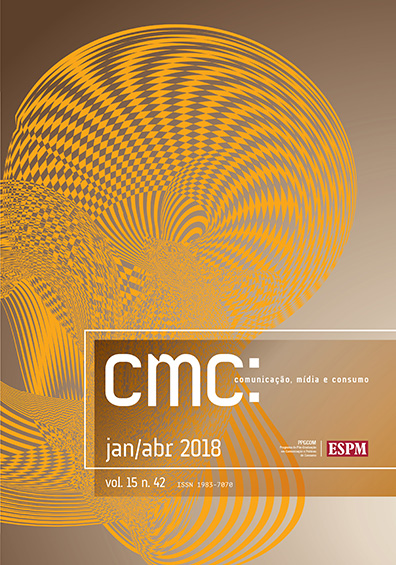The superheroes also get older? Bodies and masculinities in cartoons
DOI:
https://doi.org/10.18568/cmc.v15i42.1324Keywords:
super heroes, body, aging, masculinityAbstract
This paper analyzes comparatively two superheroes duos “Aquaman and Aqualad”, created by DC Comics, which premiered in 1960, and its parodic version (HUTCHEON, 1989) “Mermaid Man and Barnacle Boy”, SpongeBob SquarePants characters series created in 1999. This comparison aims to discuss the role of the body (LE BRETON, 2003) in the configuration of masculinities (Connell, 2003) presented in these cartoons, analyzing how each of the works draws up and submit such matters. The comparative analysis of these two superheroes duo puts into question the masculinity as a social and cultural construction that reflects a specific time, culture and society.
Downloads
References
BEIRAS, A. ; LODETTI, Alex Simon ; CABRAL, Arthur G ; RAIMUNDO, Pablo ; TONELI, Maria Juracy F. . Gênero e super-heróis: o traçado do corpo masculino pela norma. Psicologia e Sociedade (Impresso), v. 19, p. 62-67, 2007.
BRANDÃO, V. C. ; A paródia como estratégia de criação publicitária - um estudo de caso da marca Diesel. In: INTERCOM 2003, Belo Horizonte. Anais dos GT´s do Congresso Intercom 2003. Disponível em: http://www.intercom.org.br/papers/nacionais/2003/www/pdf/2003_np03_brandao.pdf. Acesso em: 14 nov. 2015.
LE BRETON, David. Adeus ao corpo: Antropologia e sociedade. Campinas, SP: Papirus, 2003.
BROWN, J. A. Comic book masculinity and the new black superhero. African American Review, 33(1), 1999, p. 25-42.
GLASSNER, B. Men and muscles. In M. S. Kimmel & M. A. Messner (Eds.), Men’s Lives (pp. 252-261). Boston: Allyn and Bacon. 1989.
CONNELL, Robert W. Maculinidades. PUEG, México, 2003.
____________. La organización social de la masculinidad. In T .Valdés & J. Olavarría (Eds.), Masculinidad/es (pp. 31-48). Santiago, Chile: FLACSO/ISIS Internacional, Ediciones de lãs Mujeres. 1997.
____________. Políticas da masculinidade. In: Educação e Realidade: Porto Alegre v. 20 n. 2 jul./dez. 1995, p. 185-206.
HALL, S. A identidade cultural na pós-modernidade. 9. ed. Rio de Janeiro: DP&A, 2004.
HUTCHEON, Linda. Uma teoria da paródia. Lisboa: Edições 70, 1989.
JIROUSEK, C. A. Superstars, Superheroes and the Male Body Image: The Visual Implications of Football Uniforms. In. Journal of American Culture, vol. 19, no. 2; Summer 1996, p. 1-13.
MEDEIROS, Rosana F. Bob Esponja: produções de sentidos sobre infâncias e masculinidades. Porto Alegre (Dissertação de Mestrado) – Universidade Federal do Rio Grande do Sul (2010).
MEDEIROS. Rosângela F. O corpo como identidade provisória: corpo, tecnologia e arte. Revista da Fundarte. Montenegro, ano 9, nº 18, p. 16-20, julho/dezembro, 2009.
SIBILA, Paula. O corpo velho como uma imagem com falhas: a moral da pele lisa e a censura midiática da velhice. Comunicação, mídia e consumo. São Paulo, ano 9, vol. 9, n.26, p.83-114 nov. 2012.
TONELI, M. J. F.; BEIRAS, A.; LODETTI, A.; GRIMM, A. C.; RAIMUNDO, P. Gênero e super-heróis: o traçado do corpo masculino pela norma. Psicologia & Sociedade; 19 (3): 62-67, 2007.
VRISSIMTZIS, Nikos A. Pederastia. In: VRISSIMTZIS, Nikos A. Amor, Sexo & Casamento na Grécia Antiga. São Paulo: Odysseus, 2002, p.100 – 114.
Downloads
Published
How to Cite
Issue
Section
License
Authors retain the copyright and grant the journal the right to first publication, with the work simultaneously licensed under the Creative Commons Attribution License that allows the work sharing with acknowledgment of authorship and initial publication in this magazine.








